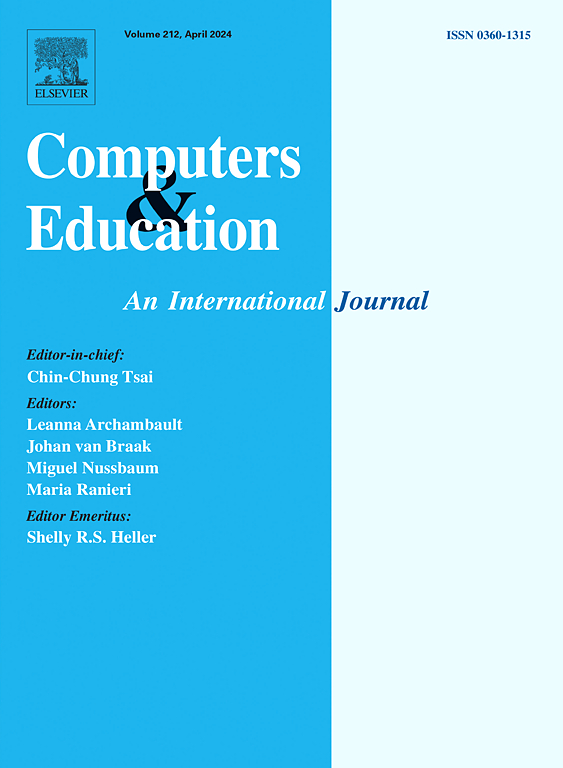虚拟陪伴或有血有肉:“和我一起学习”视频对学习者内在动机、感知压力和表现的影响
IF 10.5
1区 教育学
Q1 COMPUTER SCIENCE, INTERDISCIPLINARY APPLICATIONS
引用次数: 0
摘要
“和我一起学习”(SWM)视频为学习提供了虚拟陪伴。用户声称,SWM视频模拟了身体上的陪伴,在可控的压力下激励他们学习,并以最小的成本提高了他们的表现。尽管搜索兴趣迅速增长,累计浏览量达数百万,但SWM视频对学习的影响却缺乏严格的检验。基于不同的理论和相关证据,SWM视频相对于其他学习环境的比较优势是相互矛盾的。为了解决这些差距,我们使用基本心理需求理论(BPNT)来解释SWM视频用户的内在动机、感知压力和表现与感知自主性、能力和相关性(RQ1)。我们还将用户与SWM视频的学习情况与两种学习环境进行了比较:与物理伙伴一起学习或单独学习(RQ2)。我们采用主题内设计,邀请60名大学生在所有三种学习环境中快速阅读五篇英语文章。对于RQ1,结果表明,当使用SWM视频学习时,自主性与内在动机呈正相关,与感知压力负相关。能力与阅读时间呈负相关。因此,我们建议SWM视频创作者支持自主性和能力,并建议用户选择满足这些需求的视频。在RQ2中,尽管参与者偏好或先前使用过SWM视频,但与物理同伴相比,参与者在观看SWM视频时感受到的压力明显更低,任务准确性更高。与单独学习相比,没有统计学上的优势。我们的研究结果支持SWM视频作为物理同伴的可行替代方案,但并不优于单独学习。本文章由计算机程序翻译,如有差异,请以英文原文为准。
Virtual companionship or flesh and blood: The effects of study-with-me (SWM) videos on learners’ intrinsic motivation, perceived pressure, and performance
Study-with-me (SWM) videos offer virtual companionship for learning. Users claim that SWM videos simulate physical companionship, motivate their learning with manageable pressure, and enhance their performance with minimal cost. Despite burgeoning search interests and millions of accumulated views, the effects of SWM videos on learning lack rigorous examination. The comparative advantages of SWM videos over other learning environments, based on different theories and related evidence, are contradictory. Addressing these gaps, we used the Basic Psychological Needs Theory (BPNT) to explain SWM video users' intrinsic motivation, perceived pressure, and performance with perceived autonomy, competence, and relatedness (RQ1). We also compared users’ learning with the SWM video to two learning environments: learning with a physical companion or alone (RQ2). We employed a within-subject design with 60 university students, inviting each to speed-read five English articles in all three learning environments. For RQ1, results showed that when learning with an SWM video, autonomy was positively associated with intrinsic motivation and negatively associated with perceived pressure. Competence had a negative relationship with reading time. Thus, we advise SWM video creators to support autonomy and competence, and users to select videos that fulfill these needs. For RQ2, participants perceived significantly lower pressure and had higher task accuracy with an SWM video than a physical companion despite preference or prior use of SWM videos. No statistical advantage was found over learning alone. Our findings support SWM videos as viable alternatives to physical companions but not superior to learning alone.
求助全文
通过发布文献求助,成功后即可免费获取论文全文。
去求助
来源期刊

Computers & Education
工程技术-计算机:跨学科应用
CiteScore
27.10
自引率
5.80%
发文量
204
审稿时长
42 days
期刊介绍:
Computers & Education seeks to advance understanding of how digital technology can improve education by publishing high-quality research that expands both theory and practice. The journal welcomes research papers exploring the pedagogical applications of digital technology, with a focus broad enough to appeal to the wider education community.
 求助内容:
求助内容: 应助结果提醒方式:
应助结果提醒方式:


